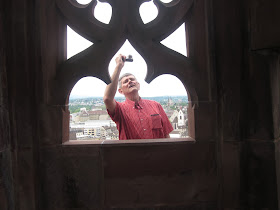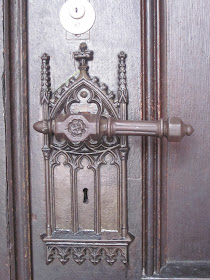Chris, Stan, Bob, and I took the night train from Budapest to Basel by way of Zurich and were met at the station at 8:30 a.m. by Dave and Pete. As I've mentioned before, it was a pretty incredible thing to meet up with all of my siblings and their spouses in an Ibis Hotel in Switzerland. After our reunion, a good breakfast, and a shower for the overnight travelers, we headed into town.
The first site we hit was the Basel Town Hall, or Rathaus:
This is the City Hall in the town where I live. Yeah, not quite the same.
Parts of Basel's Town Hall are over 500 years old. It overlooks Market Square in the center of the city, and it's not hard to imagine a 16th century farmers' market in front of these beautiful buildings.
Parts of Basel's Town Hall are over 500 years old. It overlooks Market Square in the center of the city, and it's not hard to imagine a 16th century farmers' market in front of these beautiful buildings.

The tile roof, seen below and in the pictue on the right, was quite spectacular:
Our next stop was the Basel Cathedral, or Muenster (the German word for Cathedral). This place is OLD. Like other old cathedrals, some parts have been rebuilt and others have been added to the original structure. However, the NEWEST section of this cathedral was built in 1500. Here is a bishop's tomb dated 917:
It just looks medieval, doesn't it?

I kept trying to resist yet more pictures of beautiful stained glass windows and interesting organs, but I just couldn't help myself!
Beautiful geometric patterns were everywhere--on the ends of the choir seats:
. . . and even on the floor grates:
Some of us couldn't resist the challenge of climbing the 242 steps to the top of the steeple. Who are those little ants down there?
Hey! It's Pete and Angie and Doris!
They just kept getting farther and farther away:
. . . and of the picturesque Rhine River, on which we would be spending the next week:
There were all kinds of nice things to look at:
. . . including some really fun gargoyles:
OOPS! Of course, I meant to put in this picture:
Can I just point out that these two people are 55 and 54? (Well, Chris was still two months away from 54 when this picture was taken.)
Brothers-in-law:

This is what it looked like for 242 steps on the way down. Unlike many of the spires we climbed, these stairs look like they have been recently remade.
The next building we visited was St. Elizabeth's Church, the first Protestant church in Basel after the Reformation. A plaque on the side of the building said it is one of the most famous Neo-Gothic buildings in Switzerland. It also noted, "As the church was not used as a parish church anymore there was a debate about replacing the whole building in 1968." Isn't that sad? Luckily, it was saved by becoming part of the Swiss Heritage Society and was refurbished in 1990. From this angle, it looks a bit like the Salt Lake LDS Temple:
Yeah, I know. I'm including way too many stained glass window pictures. Let me assure you that there are several hundred that I am not includiing. I love the one on the right because that is St. Elizabeth's Church in the stained glass behind the crucifixion scene. It's almost as if the church is sheltering Him.
Gotta love the details. (I was going to say "The Devil is in the details," but somehow that didn't seem right.)
The last church we visited in Basel was Peterskirche, a Lutheran church. It was built between 1200 and 1600 and was much plainer than others we had seen, more Romanesque than Gothic or Baroque. The walls were mostly painted a simple white, and there were fresh flowers used as ornamentation:
However, even here wonderful, intricate details could be discovered:
. . . and the windows and organ were just as spectacular as anywhere else:
However, I think our favorite thing in this church was the unique depiction of the Holy Trinity:
Pardon the comparison, but this makes Voldemort look like an amateur:
Of course, one of Basel's most important structures was the gelato stand. It was here that we began our Nine Days of Family Gluttony that resulted in somewhere around 142 scoops of gelato being consumed by the Kenison Ten.



















































































